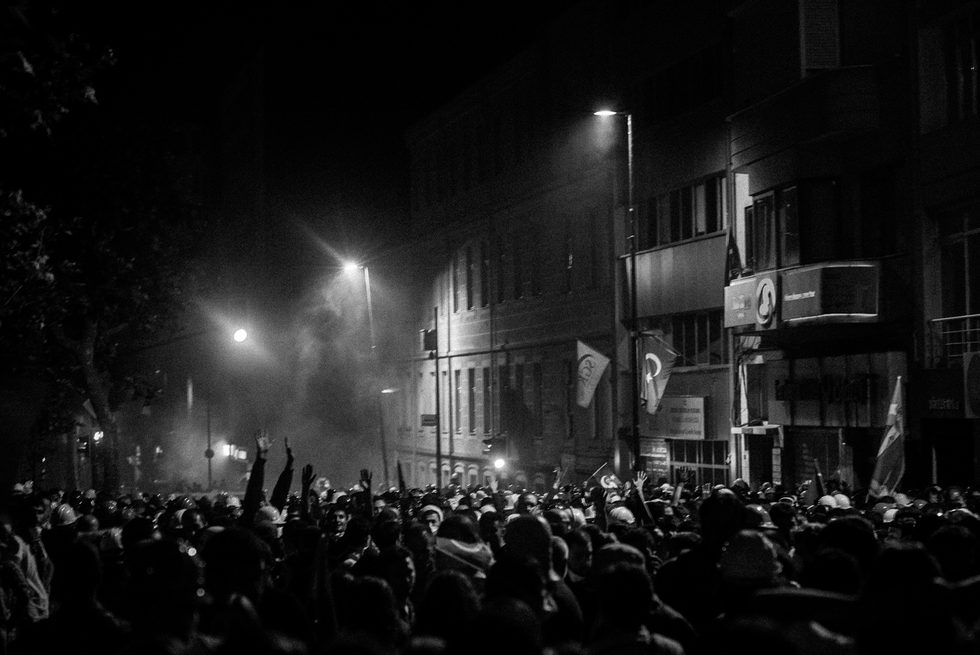Editorial—An Uprising on the Verge of Comparison
From the Series: An Impromptu Uprising: Ethnographic Reflections on the Gezi Park Protests in Turkey
From the Series: An Impromptu Uprising: Ethnographic Reflections on the Gezi Park Protests in Turkey

Just three days after tens of thousands of people took to the streets in various cities across Turkey in opposition to the authoritarian government on May 31, 2013, Turkish Prime Minister Erdogan started his tour of Morocco, Algeria, and Tunisia (the birthplaces of the Arab Spring) to boost the country’s economic influence. Walls and tweets across Turkey communicated a humorous wish addressed to him: “Please don’t come back!” Opposing the demolition of Istanbul’s Gezi Park and the plan to turn it into a shopping mall as part of a large-scale urban renewal project, protestors faced extreme police violence during a series of attacks that began on May 28. Protests soon went viral and international. Public uproar, humorous responses, and creative protests were directed against the government of Turkey, its neoliberal policies, and the conservative moral engineering it practices.
International media were enthusiastic to interpret the revolt as a late-coming, but welcome appendix to the Arab Spring as it unleashed affective forces of dissent against authoritarian rule and the personality cult of its leadership. Like the Arab Spring, the Gezi Uprising attracted an unprecedented mix of protestors ranging from opposition political parties, nationalists of sorts, radical-left organizations, anarchist groups, LGBTTQ and feminist networks, environmentalists, shanty-town dwellers resisting eviction, members of non-Muslim/non-Turkish communities, Alevi organizations, worker’s unions, students, youth, football fans, and the middle classes. The feeble participation of the Kurdish freedom movement to the uprising attracted much attention. The Kurdish movement, which sees the peace negotiations with the AKP government as a significant step toward ending decades of guerrilla war, did not want to put the peace talks in jeopardy.
It might be far-fetched, however, to compare the uprising with the Arab Spring, given the historically interlinked yet specific processes of militarism, forced uprooting, dispossession, profit accumulation, and the formation of oppositional politics in Turkey. Moreover, unlike the case of the Maghreb, the current Turkish government’s power seems to derive from speculative real-estate income and the construction business. The infrastructure plans that are part of the Erdogan government’s neoliberal policies, and central to the gentrification process major cities and villages in the countryside are undergoing, have hit sites housing villagers, immigrants, displaced Kurds, Alevis, and Roma. The poor are being hit the hardest.
The current government not only attempts to uproot and displace the poor, but to once again despoil already plundered non-Muslim/non-Turkish towns and buildings. The Turkish government’s impulsive urge to erase memory so as to replace it with profit seems to be hereditary. Some of the slogans and graffiti of Gezi—such as “who is living in Dimitri’s house?” and “Turk, Greek, Armenian, Jew, long live the brotherhood of the people”—must be understood in this historical context of property transfer and plunder in Turkey. In this respect, and in connection to global voices of dissent, the uprising could potentially challenge the ordinary Turkish subject’s insistence on not feeling his/her surroundings, and not accounting for its specters.
When, on the sixteenth day of the uprising, protests expanded into fora taking place across seventy parks in Istanbul and in various cities of Turkey, the alternative press was quick to compare this exercise in direct democracy and passive resistance with the Paris Commune and May 1968. The occupied park surrounded by barricades was referred to as the “Taksim Commune,” after the district where it is located. Such comparisons seem again far-fetched, for organic links forged between university students and worker unions during May 1968 did not blossom in the case of Gezi—with the exception of the support of university students for the ongoing occupation of the Kazova textile factory by workers who want to run the factory as an autonomous cooperative.
The lack of centralized leadership and the spontaneity of the uprising were, furthermore, compared to the global Occupy encampments. Such movements across the globe have endorsed a horizontally organized, nonhierarchical method of action, including consensual decision-making, decentralized assemblies, mutual aid networks, working groups, and rotating moderators. However, if the Occupy movements across the globe have had anarchist predecessors, the Gezi resistance was more spontaneous than organized. Historical and regional processes of dispossession, displacement, and oppositional politics on which the Gezi resistance leans are multi-layered and complex. Thus, equating its anarchic decentralization and spontaneity with anarchism would be a faux pas. No ideological cohesion binds this uprising. Its autonomy comes across as more intuitive, open to bargaining, and surprisingly self-organized. The nonviolence of the protestors might also be an effect of having witnessed heavy violence under a series of military coups, the violent suppression of the left in the 1970s, and the guerrilla war that cost more than fifty thousand lives since 1984.
The task in this Hot Spots series is to create an ethnographically fueled space for anthropological discussion about this globally connected event. Gezi might provide us with new conceptual tools with which to reflect on contemporary protests and to unhinge the central role of the Turkish nation-state in studies of European and Middle Eastern modernity. Reified approaches to the Turkish state not only block the understanding of different processes, movements, and fantasies that might become visible outside the official domain, but also run the risk of reproducing its so-called omnipresence by taking it for granted in the first place. In Turkey, protesters have vigorously challenged that so-called political omnipresence, and we seem to be awaiting what is yet to come in the near future.